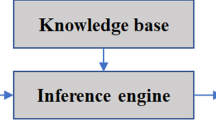Abstract
The foremost challenge faced by expert systems, for their applicability to real world problems, is their inherent deficiency of dynamism. For an expert system to be more pragmatic and applicable, the whole structure of an expert system—including rule-base, fuzzy sets, and even user-interface—needs to be upgraded continuously. This continuous up gradation demands full-time, repetitive, and cumbersome involvement of knowledge engineers. Machine learning is an answer to this problem, but unfortunately, the solutions that have been provided are limited in scope. For example, most of the researchers put forward techniques of either generating just rules from data, or self-expanding and self-correcting knowledge-base only. The innovative approach presented in this paper is broader in scope. It enhances the efficacy and viability of expert systems to be more capable of coping with dynamic and ever-changing industrial environments. The objective is facilitated by rendering, concurrently, the self-learning, self-correcting, and self-expanding abilities to the expert system, without requiring knowledge engineering skills of the developers. This means that the user needs just to feed data in form of the values of input/output variables and the complete development of expert system is done automatically. The superiority of the proposed expert system, regarding its continuous self-development, has been explained with the help of three examples related to prediction and optimization of milling and welding processes.
Similar content being viewed by others
References
Castro, J. L., Castro-Schez, J. J., & Zurita, J. M. (2001). Use of a fuzzy machine learning technique in the knowledge-acquisition process. Fuzzy Sets and Systems, 123, 307–320. doi:10.1016/S0165-0114(01)00008-2.
Chan, K. C. (1996). A comparative study of the MAX and SUM machine-learning algorithms using virtual fuzzy sets. Engineering Applications of Artificial Intelligence, 9(5), 515–522. doi:10.1016/0952-1976(96)00045-0.
Chen, Y., Hui, A., & Du, R. (1995). A fuzzy expert system for the design of machining operations. International Journal of Machine Tools & Manufacture, 35(12), 1605–1621. doi:10.1016/0890-6955(95)00024-R.
Childs, T., Maekawa, K., Obikawa, T., & Yamane, Y. (2000). Introduction. In: Metal machining: Theory and applications (pp. 1–34). London: Arnold Publishers.
Cho, S., Asfour, S., Onar, A., & Kaundinya, N. (2005). Tool breakage detection using support vector machine learning in a milling process. International Journal of Machine Tools & Manufacture, 45, 241–249. doi:10.1016/j.ijmachtools.2004.08.016.
Filipic, B., & Junkar, M. (2000). Using inductive machine learning to support decision making in machining processes. Computers in Industry, 43, 31–41. doi:10.1016/S0166-3615(00)00056-7.
Iqbal, A., He, N., Li, L., Wen, W. Z., & Xia, Y. (2006a). Influence of tooling parameters in high-speed milling of hardened steels. Advances in Machining & Manufacturing Technology, 8, 676–680 (Key Engineering Materials). doi:10.4028/0-87849-999-7.676.
Iqbal, A., He, N., Li, L., Wen, W. Z., & Xia, Y. (2006b). Empirical modeling the effects of cutting parameters in high-speed end milling of hardened AISI D2 under MQL environment. Proceedings of 2nd CIRP conference on high performance cutting, Vancouver, Canada.
Lekova, A., & Batanov, D. (1998). Self-testing and self-learning fuzzy expert system for technological process control. Computers in Industry, 37, 135–141. doi:10.1016/S0166-3615(98)00089-X.
Lounis, H. (1995). Knowledge-based systems verification: A machine-learning based approach. Expert Systems with Applications, 8(3), 381–389. doi:10.1016/0957-4174(94)E0029-T.
Monostori, L. (2003). AI and machine learning techniques for managing complexity, changes, and uncertainty in manufacturing. Engineering Applications of Artificial Intelligence, 16, 277–291. doi:10.1016/S0952-1976(03)00078-2.
Orchard, R. A. (1998). Fuzzy CLIPS, Version 6.04A; User’s Guide, National Research Council, Canada.
Priore, P., de la Fuente, D., Puente, J., & Parreno, J. (2006). A comparison of machine learning algorithms for dynamic scheduling of flexible manufacturing systems. Engineering Applications of Artificial Intelligence, 19, 247–255. doi:10.1016/j.engappai.2005.09.009.
Wang, S. Q., Li, Z. H., & Zhang, Z. P. (2006). Application of advanced self-adaptation learning and inference techniques to fuzzy Petri net expert system. Proceedings of international conference on machine learning and cybernetics (pp. 2227–2232).
Webb, G. I. (1996). Integrating machine learning with knowledge-acquisition through direct interaction with domain experts. Knowledge-Based Systems, 9, 253–266. doi:10.1016/0950-7051(96)01033-7.
Xu, D. L., Liu, J., Yang, J. B., Liu, G. P., Wang, J., Jenkinson, I., & Ren, J. (2007). Inference and learning methodology of belief-rule-based expert system for pipeline leak detection. Expert Systems with Applications, 32(1), 103–113. doi:10.1016/j.eswa.2005.11.015.
Author information
Authors and Affiliations
Corresponding author
Rights and permissions
About this article
Cite this article
Iqbal, A., Dar, N.U., He, N. et al. Self-developing fuzzy expert system: a novel learning approach, fitting for manufacturing domain. J Intell Manuf 21, 761–776 (2010). https://doi.org/10.1007/s10845-009-0252-3
Received:
Accepted:
Published:
Issue Date:
DOI: https://doi.org/10.1007/s10845-009-0252-3




